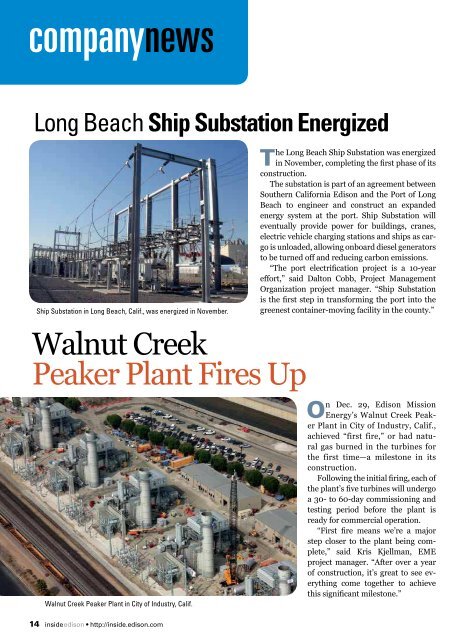Download PDF of issue - Inside Edison - Edison International
Download PDF of issue - Inside Edison - Edison International
Download PDF of issue - Inside Edison - Edison International
You also want an ePaper? Increase the reach of your titles
YUMPU automatically turns print PDFs into web optimized ePapers that Google loves.
Long Beach Ship Substation Energized<br />
Ship Substation in Long Beach, Calif., was energized in November.<br />
Walnut Creek<br />
Peaker Plant Fires Up<br />
Walnut Creek Peaker Plant in City <strong>of</strong> Industry, Calif.<br />
The Long Beach Ship Substation was energized<br />
in November, completing the first phase <strong>of</strong> its<br />
construction.<br />
The substation is part <strong>of</strong> an agreement between<br />
Southern California <strong>Edison</strong> and the Port <strong>of</strong> Long<br />
Beach to engineer and construct an expanded<br />
energy system at the port. Ship Substation will<br />
eventually provide power for buildings, cranes,<br />
electric vehicle charging stations and ships as cargo<br />
is unloaded, allowing onboard diesel generators<br />
to be turned <strong>of</strong>f and reducing carbon emissions.<br />
“The port electrification project is a 10-year<br />
effort,” said Dalton Cobb, Project Management<br />
Organization project manager. “Ship Substation<br />
is the first step in transforming the port into the<br />
greenest container-moving facility in the county.”<br />
On Dec. 29, <strong>Edison</strong> Mission<br />
Energy’s Walnut Creek Peaker<br />
Plant in City <strong>of</strong> Industry, Calif.,<br />
achieved “first fire,” or had natural<br />
gas burned in the turbines for<br />
the first time—a milestone in its<br />
construction.<br />
Following the initial firing, each <strong>of</strong><br />
the plant’s five turbines will undergo<br />
a 30- to 60-day commissioning and<br />
testing period before the plant is<br />
ready for commercial operation.<br />
“First fire means we’re a major<br />
step closer to the plant being complete,”<br />
said Kris Kjellman, EME<br />
project manager. “After over a year<br />
<strong>of</strong> construction, it’s great to see everything<br />
come together to achieve<br />
this significant milestone.”<br />
Interactive Play Teaches Kids<br />
Electrical Safety<br />
In December, <strong>Edison</strong> <strong>International</strong>, in partnership<br />
with the National Theater for Children,<br />
presented “A Bug’s Light,” a play about electrical<br />
safety, to Southern Californian elementary school<br />
students in Compton, San Bernardino, Ontario,<br />
Tulare, South Gate and Bell.<br />
The live performances educated students on<br />
how electricity is produced and used. The play also<br />
provided tips on how to identify dangerous situations<br />
and stay safe around electricity, specifically<br />
around downed power lines.<br />
“Southern California <strong>Edison</strong> wants everyone to<br />
stay safe throughout the year,” said Henry Martinez,<br />
vice president <strong>of</strong> Safety, Security & Compliance.<br />
“These school children will learn valuable<br />
lessons about electrical safety, which they can take<br />
home and share with their families.”<br />
EME Files for Chapter 11<br />
Bankruptcy Protection<br />
On Dec. 17, <strong>Edison</strong> Mission Energy<br />
filed for Chapter 11 bankruptcy,<br />
meaning EME can stay in business, operating<br />
as normal and paying its employees,<br />
while undergoing financial<br />
restructuring.<br />
EME filed for bankruptcy because low<br />
power prices and rising costs <strong>of</strong> environmental<br />
compliance led to insufficient<br />
cash flow to pay its debts.<br />
The move effectively ends <strong>Edison</strong> <strong>International</strong>’s<br />
ownership <strong>of</strong> EME, which<br />
dates back to 1986. When EME emerges<br />
from Chapter 11, it will be under new<br />
ownership. The bankruptcy filing will<br />
not impact Southern California <strong>Edison</strong>’s<br />
operations.<br />
“Several <strong>of</strong> us have long histories with<br />
EME and this is indeed a difficult parting<br />
made necessary by financial conditions,”<br />
said Ted Craver, <strong>Edison</strong> <strong>International</strong><br />
chairman and CEO.<br />
“A Bug’s Light” taught elementary school students<br />
about electrical safety.<br />
PCB Removal Program<br />
Success in 2012<br />
Southern California<br />
<strong>Edison</strong> established<br />
a program<br />
in 2009 to identify<br />
and remove approximately<br />
6,000 distribution<br />
transformers<br />
suspected <strong>of</strong> containing<br />
high levels<br />
<strong>of</strong> polychlorinated<br />
The PCB removal program replaced 91<br />
biphenyl, or PCB, distribution transformers verified to contain<br />
an environmentally high levels <strong>of</strong> PCB in 2012.<br />
toxic pollutant sometimes<br />
found in transformers manufactured prior<br />
to 1980. In 2012, the program aimed to remove 96<br />
contaminated transformers and achieved a 95 percent<br />
success rate, removing 91 distribution transformers<br />
verified to contain high levels <strong>of</strong> PCB.<br />
“The program goal is to remove suspect units<br />
before they leak, potentially releasing PCBs, which<br />
results in more costly cleanup efforts than removing<br />
them while intact,” said Mary Zepeda, Corporate<br />
Environmental Services project manager.<br />
In 2013, the program aims to remove 136 contaminated<br />
transformers.<br />
14 insideedison • http://inside.edison.com http://inside.edison.com • january 2013 15

















